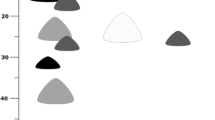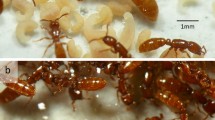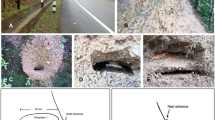Abstract
The dimorphic ant, Pheidole morrisi Forel, is the most common ant of the longleaf pine flatwoods ecosystem of northern Florida and occurs throughout the eastern USA. Although ecologically significant, its life history, and annual cycle have been little investigated. The effects of colony size and the annual cycle were described by collecting the full range of colony sizes during each of five seasonal phases (n = 40 total). Nests were cast in wax to capture and census all colony members, and to determine their vertical distribution within the nest. Colony sizes ranged from 800 to 49,000 ants, larger than previous literature reports. Colonies invested in worker production during the spring and fall and reduced worker production as they produced alates in the summer. Colonies over 3000 workers were able to produce alates, but the number was not related to colony size. Vertical distribution of nest volume was strongly top heavy, with the greatest proportion of the nest volume near the surface. The mean weight of majors was about four times that of minors. The mean percentage of total workers that were major workers (11 % by number, 30 % by weight) did not change significantly as colonies grew, but varied with season. Production of major pupae was highest in spring, so that the percentage of colony biomass represented by majors increased from about 27 % in spring to 38 % in late summer. The overall density of the ants was highest in medium-sized colonies, lowest in small colonies, and moderate in large colonies. Broadly, the colony moved lower in the nest from summer to winter and higher from winter to summer. The seasonal vertical distribution of ants suggested that the ants responded to temperature, but not crowding. Temperatures in the nest varied from 12 to 17 °C in the winter to 23–33 °C in the late summer. Broods were nearly always found in the warmest regions. The distribution of callow workers was strongly correlated with that of the brood. The results are discussed in light of the utility of the wax-casting method and the nature of the data needed to describe and understand the superorganism.














Similar content being viewed by others
References
Calabi PS, Porter SD (1989) Worker longevity in the fire ant Solenopsis invicta: ergonomic considerations of correlations between temperature, size and metabolic rates. J Insect Physiol 35:643–649
Conway JR (2003) Architecture, population size, myrmecophiles, and mites in an excavated nest of the honey pot ant, Myrmecocystus mendax Wheeler in Arizona. Southw Nat 48(3):449–450
Frost CC (1993) Four centuries of changing landscape patterns in the longleaf pine ecosystem. In: Proceedings of the Tall Timbers Fire Ecology Conference no. 18, pp. 17–43
Gregg RE (1942) The origin of castes in ants with special reference to Pheidole morrrisi Forel. Ecology 23:295–308
Hölldobler B, Wilson EO (1990) The ants. The Belknap Press of Harvard University Press Cambridge, Massachusetts
Jandt JM, Dornhaus A (2009) Spatial organization and division of labour in the bumblebee Bombus impatiens. Anim Behav 77:641–651
King JR, Tschinkel WR (2008) Experimental evidence that human impacts drive fire ant invasions and ecological change. PNAS 105:20339–20343
Kipyatkov VE (1993) Annual cycles of development in ants: diversity, evolution, regulation. In: Kipyatkov VE (ed) Proceedings of the colloquia on social insects, vol 2. Russian-speaking section of the IUSSI, Socium, St. Petersburg, pp 25–48
Kipyatkov VE (1995) Role of endogenous rhythms in the regulation of annual cycles of development in ants (Hymenoptera, Formicidae). Entomol Rev 74(7):1–15
Kipyatkov VE (2006) The evolution of seasonal cycles in cold-temperate and boreal ants: patterns and constraints. Life cycles in social insects: behavior, ecology and evolution. St. Petersburg University Press, St. Petersburg, pp 63–84
Kipyatkov VE, Elmes G et al (2001) Physiological and ethological adaptation by Myrmica ants to short summers. In: Proceedings of the 2001 Berlin Meeting of the European Sections of IUSSI, Berlin, p 111, 25–29, September 2001
Kwapich CM, Tschinkel WR (2013) Demography, demand, death and the seasonal allocation of labor in the Florida harvester ant (Pogonomyrmex badius). Behav Ecol Sociobiol 67:2011–2027. doi:10.1007/s00265-013-1611-9
Laskis KO, Tschinkel WR (2009) The seasonal natural history of the ant, Dolichoderus mariae (Hymenoptera: Formicidae) in northern Florida. J Insect Sci 9:2
Markin GP, Dillier JH, Collins HL (1973) Growth and development of colonies of the red imported fire ant, Solenopsis invicta. Ann Entomol Soc Amer 66:805–808
Moreau CS (2008) Unraveling the evolutionary history of the hyperdiverse ant genus Pheidole (Hymenoptera: Formicidae). Molec Phylog Evol 48:224–239
Muscedere ML, Willey TA, Traniello JFA (2009) Age and task efficiency in the ant Pheidole dentata: young minor workers are not specialist nurses. Anim Behav 77(4):911–918
Oster GF, Wilson EO (1978) Caste and ecology in the social insects. Princeton University Press, Princeton
Patel AD (1990) An unusually broad behavioral repertory for a major worker in a dimorphic ant species: Pheidole morrisi (Hymenoptera: Formicidae). Psyche 97:181–191
Penick CA, Tschinkel WR (2008) Thermoregulatory brood transport in the fire ant, Solenopsis invicta. Insect Soc 55:175-172
Porter SD (1983) Fast, accurate method of measuring ant head widths. Ann Entomol Soc Amer 76:866–867
Porter SD (1990) Thermoregulation in the fire ant Solenopsis invicta. In: Veeresh GK, Mallik B, Viraktamath CA (eds) Social insects and the environment, vol 660. Oxford & IBH Publ. Co. Pvt. Ltd, New Delhi
Porter SD, Tschinkel WR (1993) Fire ant thermal preferences: behavioral control of growth and metabolism. Behav Ecol Sociobiol 32:321–329
Seid MA, Traniello JFA (2006) Age-related repertoire expansion and division of labor in Pheidole dentata (Hymenoptera: Formicidae): a new perspective on temporal polytheism and behavioral plasticity in ants. Behav Ecol Sociobiol 60:631–644
Sendova-Franks AB, Franks NR (1995) Spatial relationships within nests of the ant Leptothorax unifasciatus (Latr.) and their implications for the division of labour. Anim Behav 50:121–136
Smith CR, Tschinkel WR (2006) The sociometry and sociogenesis of reproduction in the Florida harvester ant (Pogonomyrmex badius). J Insect Sci 6:32
Tschinkel WR (1987) Seasonal life history and nest architecture of a winter-active ant, Prenolepis imparis. Insect Soc 34:143–164
Tschinkel WR (1988) Colony growth and ontogeny of worker polymorphism in the fire ant, Solenopsis invicta. Behav Ecol Sociobiol 22(2):103–115
Tschinkel WR (1991) Insect sociometry, a field in search of data. Insect Soc 38:77–82
Tschinkel WR (1993) Sociometry and sociogenesis of colonies of the fire ant Solenopsis invicta during one annual cycle. Ecol Monog 63(4):425–457
Tschinkel WR (1998a) Sociometry and sociogenesis of colonies of the harvester ant, Pogonomyrmex badius: worker characteristics in relation to colony size and season. Insect Soc 45:385–410
Tschinkel WR (1998b) Sociometry and sociogenesis of colonies of the harvester ant, Pogonomyrmex badius, in relation to colony size and season: distribution of workers and seeds in the nest. Ecol Entomol 24:222–237
Tschinkel WR (1999) Sociometry and sociogenesis of colonies of the harvester ant, Pogonomyrmex radius: distribution of workers, brood and seeds within the nest in relation to colony size and season. Ecol Entomol 24:222–237
Tschinkel WR (2002) The natural history of the Arboreal ant, Crematogaster ashmeadi (Hymenoptera: Formicidae). J Insect Sci 2:12
Tschinkel WR (2003) Subterranean ant nests: trace fossils past and future? Palaeogeogr Palaeoclimatol Palaeoecol 192:321–333
Tschinkel WR (2004) The nest architecture of the Florida harvester ant, Pogonomyrmex badius. J Insect Sci 4(21):19
Tschinkel WR (2006) The fire ants, vol 747. Harvard University Press, Cambridge
Tschinkel WR (2010) Methods for casting subterranean ant nests. J Insect Sci 10:88
Tschinkel WR (2011) Back to basics: sociometry and sociogenesis of ant societies (Hymenoptera: Formicidae). Myrmecol News 14:49–54
Tschinkel WR, Murdock T, King JR, Kwapich C (2012) Ants and groundwater in the north Florida flatwoods. J Insect Sci 12:114
Vargo EL (1988) Effects of pleometrosis and colony size on the production of sexuals in monogyne colonies of the fire ant Solenopsis invicta. In: Trager JC (ed) Advances in myrmecology. Brill EJ, Leiden, pp 217–225
Wheeler DE (1986) Developmental and physiological determinants of caste in social Hymenoptera: evolutionary implications. Am Nat 128:13–34
Wilson EO (1975) Enemy specification in the alarm-recruitment system of an ant. Science 190:798–800
Wilson EO (1976) The organization of colony defense in the ant Pheidole dentata Mayr (Hymenotera: Formicidae). Behav Ecol Sociobiol 1(1):63–81
Wilson EO (1984) The relation between caste ratios and division of labor in the ant genus Pheidole (Hymenoptera: Formicidae). Behav Ecol Sociobiol 16:89–98
Wilson EO (1985) The sociogenesis of insect colonies. Science 228:1489–1495
Wilson EO (2003) Pheidole in the new world: a dominant and hyperdiverse ant genus. Harvard University Press Cambridge, Massachusetts
Yang AS (2004) Geographic variation of caste structure among ant populations. Curr Biol 14:514–519
Yang AS (2006) Seasonality, division of labor, and dynamics of colony level nutrient storage in the ant Pheidole morrisi. Insect Soc 53:456–462
Acknowledgments
Ryan Reynolds, Christine Stevens, Caleb Vaughn, and Alice Mallory provided help in the field. The Florida State University Antarctic Research Facility allowed us to store wax casts in their freezer. Christina Kwapich provided helpful comments and discussion. This work was partially supported by National Science Foundation IOS 1021632.
Author information
Authors and Affiliations
Corresponding author
Rights and permissions
About this article
Cite this article
Murdock, T.C., Tschinkel, W.R. The life history and seasonal cycle of the ant, Pheidole morrisi Forel, as revealed by wax casting. Insect. Soc. 62, 265–280 (2015). https://doi.org/10.1007/s00040-015-0403-9
Received:
Revised:
Accepted:
Published:
Issue Date:
DOI: https://doi.org/10.1007/s00040-015-0403-9




